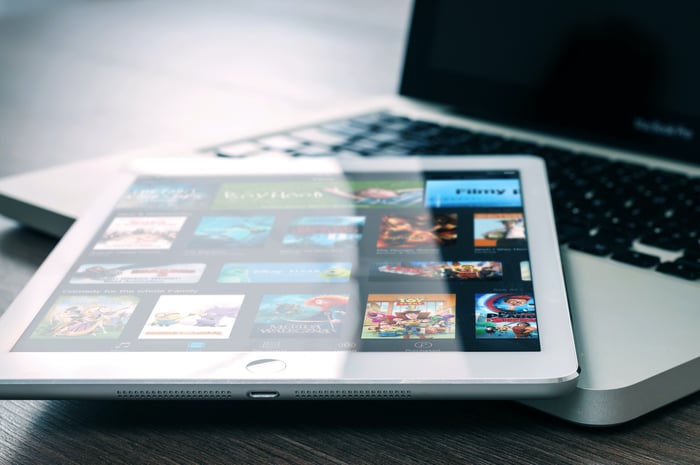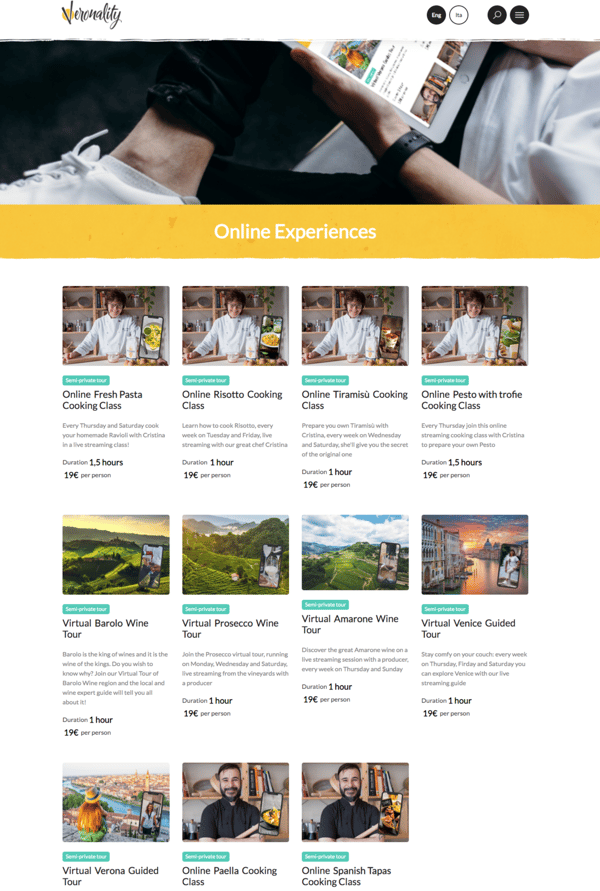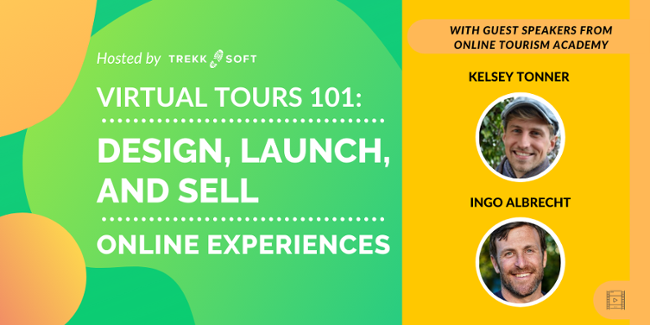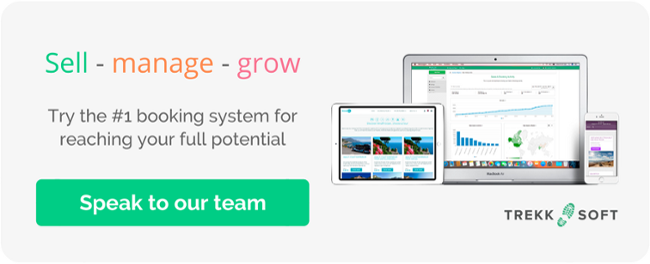Before low-cost travel became an experience everyone enjoyed, my mother grew up reading books when she wanted to explore the world. She didn't know that Buttercups were flowers until she touched one on her first visit to England in her late 20s. Today, the internet has replaced the role books once played, and much of the travel experience begins online and at home.
Last week, Airbnb joined Viator and GetYourGuide to offer virtual experiences. Given the sudden halt in the travel industry, many operators are wondering if going virtual could be a way to open up new revenue streams to stay afloat.
In this blog post, get an overview of everything you need to know about virtual tours.
- What are virtual experiences?
- Types of virtual products
- The benefits of virtual tours
- The downside to virtual tours
- Interview with Veronality, a tour company that launched virtual tours
- Tips to run 5-star experiences online
- How to set up your TrekkSoft booking system to sell virtual experiences
Creating a virtual experience = Creating a new product
In a panel discussion hosted by Kelsey Tonner from Be A Better Guide, Avital Ungar of Avital Tours highlighted the difference in consumer behaviour when it comes to going on tour in-person and going on tour virtually. She noted how companies cannot simply take existing tours, record them, and post them online.
Daphne Tsevreni Co-founder of Clio Muse Tours also shared how their company intentionally created shorter programmes with a mix of fun facts, history and personal stories in their virtual tours to adapt to limited attention span of their audiences at home.
Types of virtual products
From what I can gather, these are the four broad categories virtual tours can fall in:
1. Pre-recorded tours
This is a recording of your tour that is shared with customers after they've paid. The on-demand recording could be of your guide sharing insights about a destination or a specific topic, or it could be a vlog-like recording of a tour around your destination.
Examples of this include Street Wisdom's Street Wisdom Comes Home video series.
2. Live tours
You could set up live tours using tools like Google Hangouts, Zoom or GoToWebinar. These types of experiences are great if you want to provide opportunities for interaction between your guide and your customers.
This category is where Airbnb's online experiences fall into.
3. Semi-immersive tours
These tours often involve a physical element whether it's something delivered to the customers' homes or something they are able to purchase themselves to prepare for the tour. It is then paired with some sort of virtual experience whether it's a live call or a recording.
Examples of this include wine or beer tastings at home, or Dewakan's Cook Like Dewakan Food Kit.
4. 360 tours
Got one of those 360 cameras? Now is a great time to experiment with the different 3D experiences you can create with them.
Examples of such tours include museum tours like the one offered by the National Art Gallery in London.
Advantages of virtual products
Apart from providing a new revenue stream for your company, going digital can also bring other advantages to your business.
Quick feedback loops
The good thing about digital products is that you are able to quickly gather feedback about the experience, improve the experience, launch the updated version, rinse and repeat.
You can use free tools like Google Forms to get feedback and turn this into valuable insights for your product.
Easier distribution
We've extensively covered the pros and cons of working with resellers or becoming a reseller yourself. With digital tours, the sales process should not look very different from a real-world tour. You can use the same affiliate links you have in place with existing resellers to track sales and commissions.
Do take note of distribution costs when you price your digital product.
Great engagement tool
Digital tours can also be a great lead magnet to grow your existing mailing list, while also engaging and cultivating existing leads in your sales funnel. A well thought out virtual tour could give leads a taste of the real-life experiences you could offer them in the future.
Even if you decide that virtual tours isn't something you want to pursue, you should still be spending this downtime building up your list of leads so that you have a pool of potential buyers to reach out to when the time is right.

Disadvantages of virtual tours
What sort of blog post would this be if we ignored the potential downsides to going virtual? Here are a couple disadvantages to consider.
Competition for consumer attention
In his Arival Online Ask Me Anything interview, Tao Tao, COO of GetYourGuide noted that the online entertainment space is currently occupied by Netflix and online games. Let us not forget about how much time we also spend on social media sites, the latest trend being Tik Tok.
Given that not all companies have experience in creating and marketing digital experiences, attracting consumer attention in this cluttered space could be a challenge.
The industry is still experimenting
If we're honest with ourselves, the industry is experimenting with this new type of product, and no one can say with full confidence that this will work out.
Arival wrote recently how they too are sceptical that this pivot to digital can truly make a difference when compared to the loss in revenue from the current crisis.
"Much remains to be seen whether virtual tours can really compete for consumer attention and help operators through the downturn. But this wave of experimentation is sure to result in plenty of learnings and innovation that will make the Best Part of Travel even better."
Hear from a company that has launched virtual tours
Interview with Matteo Pasqualotto from Veronality, an Italian tour operator
Why did you decide to sell virtual tours?
Here in Italy we went into lockdown about one month before other countries. In that period, my team and I received many emails from our customers asking about our health. When our customers went into lockdown, we knew they had a lot more free time so we thought about entertaining them by virtually travelling in our beautiful country.
In late March, we started creating our online experiences about cooking, tasting and discovering historical cities.
Was it difficult to set up virtual tours on your website?
Not at all. That said, we had never create anything like it and we had very few examples to follow, so we started creating everything new. As we wanted to create virtual, live, and interactive experiences, we checked all of the platforms available online (Zoom, Webex, Hangout, etc.) because we wanted the best one to help us to interact with our guests.
After that, we set up the new products on our TrekkSoft booking platform which really helped us to automate everything: booking, payment, notifications, etc.
What equipment, tools or software do you use to run your virtual tours?
For the meeting platform, we decided to use Zoom. After checking many others, I think it is one of the best for hosting virtual, interactive, and live experiences. With Zoom, you can share slides, organise Q&A sessions with a live quiz, and easily interact with your guests. We also started selling our tours on Airbnb where it is mandatory to use Zoom.
Since all of our team members work from home, some use a computer, others a tablet or a smartphone to run the experience.
I think the most important thing is the internet connection. At this time, we cannot sell some virtual tours because some of our team members don’t have a good connection in their cities.
How did you create your virtual tours? How did you prepare your guides for these types of tours?
Many of our team members are guides, they are not independent but internal. Our team worked together to prepare these virtual tours, spending many hours discussing how virtual tours compare to real tours. Everyone worked together, marketing department, booking department, guides and chefs.
As tour operators, our main focus is to deliver high quality tours with high interaction levels with guides during our small-group and semi-private tours. Our mission is to create unforgettable experiences with real Italian locals.
When we decided to create virtual, live, and interactive experiences, we realised that this new product is something different. Instead of thinking about what we could not do online, for example easily interact with guests, see a monument in person, or taste wine together; we saw that online experiences give you the opportunity to do more things a real-life tour cannot, for example watching a video, listening music, covering a larger area than a regular walking tour, and more.
How did you set your prices?
To me, the price setup is very hard for virtual tours because on the internet you can find so much free content about everything - cities, museums, wines, recipes, and more.
We worked hard to create our own content, to test the tours, to setup platforms and the website, but we don't think about these things as a "cost". One of my colleagues said to me that it is difficult to sell enough virtual tours for a good ROI and I think that's true. Nowadays, you can’t think only about your ROI, you also need to think about your customers, your audience and your brand awareness.
How did you market your tours and what was the response from customers?
First of all we started promoting these experience to most of our previous guests through direct email. We also promoted our virtual tours on social media networks like Facebook and Instagram. The response was quick and very positive.
However, as soon as our customers starting booking, it was evident that a large audience or following is necessary to continue to promote these experiences. We also found that customers don't really understand what online experiences are and don't really see a need for them right now.
Given that we're still in early stages of virtual tours, I hope to see rapid growth in virtual products in the coming months.
What is the one thing all operators should know before trying out virtual tours?
Operators need to know that virtual products are different from the tourism market and the virtual tours are very different from the in-person or traditional tours. A virtual tour might seem easy to produce and sell, but it is very challenging to create a 5-star experiences. I think this is a great opportunity for the operators to improve on the quality of their online experiences.
Virtual tours might have started off as entertainment content for those in lockdown, but I think in the future, they will be an incredible way for customers to plan upcoming trips. For operators, virtual tours can be a great way to promote destinations, attractions and in-person tours.
What makes a good online tour?
Mini case study with Rachel Crowther on Street Wisdom Comes Home
Street Wisdom offers free walks in 42 countries around the world, helping people find answers to important questions in life and work by drawing inspiration around them. In light of the pandemic, they've released "Street Wisdom Comes Home". Rachel Crowther, producer at the organisation, shares why they decided to step into the digital space.
What sparked Street Wisdom to move into the digital space?
As the name suggests [the programme is] designed to be done out and about in the busy city streets, where people are (normally) rushing from A to B. The process helps people to slow down and notice what’s right in front of them. Recent events have unfortunately led most people to be confined to their homes, our pace of life has changed dramatically and we’ve all had to slow down and reflect. We realised that Street Wisdom was needed more than ever to guide us through these challenging times and we don’t have to be out and about to find inspiration, it’s all around us.
People have been using the Street Wisdom Comes Home process to find answers and inspiration in their own homes, on their bookshelf, in their kitchen - it’s been incredible. This is also a time in which people are thinking about what’s next: what do they want to do and be, what will the world be like or what do we want it to be like?
Street Wisdom founder, David Pearl, actually released a book at the start of the year all about how to navigate complex times with your inbuilt guidance system. It’s called Wanderful, you can read more about it here.
What are the top 3 things that make a good virtual experience?
1. The session is virtual but be prepared to go on a physical quest.
2. Wanderful the Street Wisdom book is an excellent aid. It guides you through the process and background, with exercises to try and real life experiences.
3. Nothing else. We like to say you don’t pay fees, you pay attention.
Nicole's takeaways:
- Remind people to pay attention at the start of each experience. That includes closing other tabs in their browsers, silencing their phones and limiting other distractions.
- Self-guided tours can be a lot more interactive with printable guides to enhance the experience. Whether participants can draw on them, write on them or fold them into something fun, it's a good way to increase physical engagement throughout the experience.
Mini interview with Ingo Albrecht from Be A Better Guide
The team at Be A Better Guide have just launched a new programme called Virtual Tour Business to help operators transition into the world of digital.
What sort of tour companies should consider creating virtual experiences?
We have spent a lot of time researching virtual tour businesses and have found a huge variety of companies that have successfully launched virtual tours. We have seen food tours, history tours, cooking classes, online nature tours, virtual happy hours, guided tastings, online history trivia, zoo tours, virtual cultural tours of various cities, film experiences, virtual masterclasses, online seminars with experts and the list goes on.
So many tour companies are finding ways to move their content into a virtual format. Food tours were amongst the fastest to pivot using shipping services to send boxed food to people's homes but other companies are quickly catching up.
What are the top 3 things that make a good virtual experience?
There are many things that make a good virtual experience but it depends a little bit on how you plan to scale and monetize. A few things that lead to success are:
1. Harnessing the talent, expertise, and partners of the original tour business
2. Finding a format that gives your customer perceived value. This could be a personalized approach through live Q&A sessions, videos or experiences that share little hidden secrets, or things that provide immediate joy to your customers in the comfort of their home. People can't travel right now and if you give them the ability to experience, dream, and feel joy, you are helping them tremendously.
3. A product that gives a different approach than your traditional tours. This will allow it to continue having value even after travel restrictions are lifted.
Nicole's takeaways:
- Start by asking what your customers value, then leverage on existing knowledge and expertise within your company to build an interesting experience.
- Digital products could be a consistent revenue stream in the long-run too.
Catch our webinar with Ingo and Kelsey to learn all about setting up virtual tours
Remember the technical stuff
1. Good internet connection - If you opt for a live virtual tour, having a stable connection is necessary for both you and your customers.
2. Reliable website to host your videos - If you opt to sell recorded tours, having a stable site to host your videos is important. A really basic tool you can use is YouTube. Simply upload the video to YouTube and make sure that it is "Unlisted" and only share the link with people who have paid you for your product.
3. Remind your customers about the technical stuff too - Just like how you would remind customers to bring a bottle of water with them on a trip, remind them to install Zoom before a call, or make sure that their camera and microphone works to fully enjoy the experience.
Marketplaces for Online Tours and Experiences
If you're not sure about rehauling your entire website for this experiment, here are some marketplaces where you can list your virtual tours.
Get Your Guide
The Tour Guy
With Locals
Airbnb
How to use TrekkSoft to sell your digital products
I spoke to Licia Moura, one of out Account Managers at TrekkSoft for tips on how TrekkSoft users can set up their booking systems to process bookings for virtual tours.
How would operators set up their schedules for a pre-recorded tour?
I'd say the booking process would be the same. Users can set up vouchers with no start or end times, and no limit to how many people can purchase the tour.
How can operators automatically register customers for a live experience?
If they're using Zoom, they can use our integration with Zapier to automatically generate a new webinar or add guests to an existing webinar.
Can operators use the resource manager to notify guides and keep track of guides being allocated to a tour?
Yes, you can use the setup the resource manager to notify the guide and email them a guest manifest of the tour as well. You can also track when guides are being assigned to a tour by checking the resource calendar.
Learn how to setup your resource manager here.
Learn how to TrekkSoft can help you sell and manage your bookings







